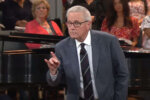He has the unenviable task of following in the tracks of a NASCAR legend-chasing records that may never be broken. But make no mistake, Kyle Petty is his own man … fueled by a desire to leave his mark on the racing world and to carry on the work of the son he lost five years ago.
For a moment, the ground is still. The toxic smell of burnt rubber and 110-octane leaded gasoline has yet to be released into the air. On this warm August day in Michigan, 43 drivers climb into race cars riddled with corporate logos, eagerly anticipating the famous call to start their engines.
The skies are clear, so comparing the pre-race atmosphere to the cliché “calm before the storm” doesn’t exactly work out. In fact, once the speedway goes “hot,” it will feel a lot more like an earthquake than any meteorological phenomenon.
As crews make final preparations in pit road and the sold-out crowd of over 137,000 waits in anticipation, Tim Griffin takes a deliberate walk down the starting grid. As one of chaplains for Motor Racing Outreach (MRO), he has the unique privilege of praying with each driver individually.
Griffin doesn’t ask God for any particular result. Tony Stewart, for instance, gets the same prayer as his championship rival Jimmie Johnson. Instead, it’s a simple petition for safety and protection.
When Griffin hits the 35th position, he finds an especially friendly face in Kyle Petty. A long-time supporter of MRO, Petty strikes up a conversation with Griffin about the ministry.
It’s not really surprising that a NASCAR driver is actually in touch with his spiritual side. After all, NASCAR is the only major professional sports body left that bucks political correctness in exchange for open displays of faith. Part of every race day’s opening ceremonies includes a public invocation. But there’s something that stands out about Petty that goes way beyond the trademark ponytail and matching goatee that he sports or the fact that he runs marathons and spends as much time on a motorcycle as he does in a race car.
“As somebody standing up front speaking to people, you’ll make eye contact with people in your audience,” Griffin explains. “Kyle is one of those individuals who will reflect that ‘racer’s face,’ that racer’s concentration, in chapel.
“When you’re speaking, he’s riveted. He’s like, ‘Give me what I came for, what I need to hear from God today.’ That’s not always true for everybody that sits in chapel service. They drift. They’re thinking about the race. But Kyle’s one of those guys that tends to sit right in the center and maybe three or four or five rows from the front, and he’s right there. He’s locked in to what you have to say and what you’re trying to communicate.”
Petty has been serious about his faith in Jesus Christ for as long as he can remember. It only seems fitting that he became an icon in a sport that likewise embraces Christian values.
“[Faith] has an important place in this sport,” Petty tells New Man. “Even though the demographics continue to change, this is still a grassroots, blue-collar sport. America is still basically a blue-collar nation and a grassroots working man’s nation. And when you go there and you talk to those people, what’s the center of their life? The center of their life is Wednesday night prayer meeting and Sunday morning church service and Sunday School. Then they’ll go watch a race or watch football. But they’ve got to go do that first.”
NASCAR’S ‘FIRST FAMILY’
By early October, the warm summer air has been replaced by cool breezes and milder temperatures. It’s Friday in Kansas City, Kan., and while the Banquet 400 doesn’t take place for two more days, the Kansas Motor Speedway is already buzzing with activity.
Kyle’s father, NASCAR legend Richard Petty, is standing outside his enormous motor coach having an intense conversation with a member of the Petty Racing team. His travel vehicle is one of dozens parked side by side in a special section of the speedway’s infield reserved for Nextel Cup participants.
It’s hard not to be a little intimidated by a man who’s often referred to as “The King” rather than his given name. He dons his trademark black cowboy hat and pitch-dark sunglasses. The mid-morning chill has forced him to break out a full-length, black coat that blends seamlessly into his black cowboy boots.
For Kyle Petty, it certainly doesn’t hurt to have the King around for moral support and guidance. Richard travels to nearly every race to promote the Richard Petty Driving Experience, a traveling school that gives average Joes the chance to get behind the wheel of a real-life race car. He also hangs around to keep tabs on Kyle and the Petty Racing teams.
“It’s good [to have him around],” Kyle says. “Experience counts for a lot. Exuberance and youth count for a lot, too, but experience counts for a lot. And it’s hard sometimes to know where you’re going unless you know where you’ve been.”
The Petty legacy didn’t start with Richard, but with his father, Lee Petty. In 1949, Lee set NASCAR’s proverbial wheels into motion and became one of the true pioneers of auto racing by winning 54 races and three championships in just 15 years of competition. Lee Petty also took home the inaugural Daytona 500 title in 1959 and was named one of NASCAR’s 50 Greatest Drivers. He passed away in April of 2000 at the age of 86.
If Lee Petty got the wheels to turn, then Richard Petty, 68, set the tires ablaze. The King’s storied career lasted 33 years (1959-1992) and included a record 200 victories and seven NASCAR championships (matched only by the late Dale Earnhardt). In 1971, he became the first driver to win $1 million, and in the year of his retirement, he received the Medal of Freedom-the highest honor paid to a U.S. civilian.
Kyle Petty was born in June of 1960, right in the middle of Richard’s busy racing schedule. He’s been caught up in the sport ever since. Kyle has spent most of his 45 years either working on or driving in a race car.
Part of the Petty lifestyle includes team ownership. Through the end of the 2005 race season, Petty Enterprises was running two teams: the No. 45 car driven by Kyle and the No. 43 car driven by Jeff Green (they will continue to run two cars in 2006 with Kyle in No. 45 and Bobby Labonte in No. 43). Not only does Kyle drive for his team, he also drives the entire operation.
And NASCAR is a big business. How big? For starters, it is now the second most popular professional spectator sport in terms of television ratings inside the United States, ranking behind only the National Football League. It also holds 17 of the top 20 attended sporting events in the United States and has 75 million fans who purchase over $2 billion in annual licensed product sales. These fans are considered the most brand-loyal in all of sports, and as a result, Fortune 500 companies sponsor NASCAR more than any other sport.
Those sponsorships don’t come cheap. An associate sponsorship on a race car (a company logo on the lower rear quarter panel) costs anywhere from $50,000 to $500,000. Big business, indeed. Big pressures, too.
In fact, Kyle Petty is one of the few driver/managers in the sport today. Busch Series driver Jason Keller used to relate to Petty’s crazy life. That is, until he couldn’t handle it anymore.
“I don’t see how he does it,” Keller says. “I owned my own team in the mid-90s when I first came into the sport. When my son was born, I realized that I couldn’t do it all. I couldn’t drive, own a car and be a dad, so I chose to sell my family-owned team and go a different route. I commend him. I don’t see how he has enough time in a day.”
While Kyle Petty is years away from his father’s accomplishments on the track, the younger Petty can take solace in the fact that most everyone else is in the same position-chasing records that may never be broken.
That’s not to say that Kyle Petty hasn’t left his own set of fresh tracks on the racing world. Since 1979, he has forged a respectable career that includes eight Nextel Cup (formerly Winston Cup) victories, 51 top-five finishes and 170 top-10 finishes.
Petty hasn’t won a race since taking the checkered flag at Dover in 1995, but that hasn’t stopped his competitive juices from flowing. In 2005, he managed two top-10 finishes, including an eighth-place run at the Food City 500 in Bristol, Tenn.
Some wonder if the Petty name has been a blessing or a curse. The expectations have certainly been high, but according to Tim Griffin, Kyle Petty has been fearless in his pursuit of excellence both on and off the track: “He’s taken that sense of responsibility of being the son of the most famous driver in NASCAR and has obviously not let that intimidate him. Kyle is his own man. He doesn’t try to be his dad, which is hard to do, no doubt. He’s been his own man. He’s been his own person. He’s made his own decisions and not for his own benefit but for the family name and how that would contribute to other people.”
ADAM’S WAY
By 2000, the Pettys had become NASCAR’s first four-generation racing family thanks to the emergence of Adam Petty, Kyle’s oldest son. At the age of 20, he was learning the ropes in the Busch Series and was preparing for a move to NASCAR’s top level.
But before Adam’s career could truly take off, his life ended tragically when he crashed into the wall during a practice round at the New Hampshire International Speedway. The entire NASCAR community mourned. Adam had been hanging around the garages since he was a young boy, and according to Richard, many of the drivers had “sort of adopted him.”
During his life, Adam had shown interest in charity work, focusing his energies on children’s organizations. Even before Adam’s death, the family had talked about building a camp for children living with chronic illnesses. But after he died, it became their main focus, Petty says. Kyle and his wife, Patty, dove headlong into the work of establishing Victory Junction Gang Camp. Richard donated 72 acres of land in Randleman, N.C., and according to Kyle, “everything just started falling in place.”
Dale Jarrett donated $50,000 to get things moving. Bobby Labonte donated a car that was auctioned off for the camp. Tony Stewart and the Busch brothers got involved with their charity groups. Michael Waltrip raised money by running a marathon, and Kevin Harvick’s fan club collected over $50,000.
In 2002, the camp became the first official charity of NASCAR. Then, race team sponsors got involved-Bass Pro Shops, Tyvek, Georgia Pacific and Pizza Hut, just to name a few. And the Pettys needed all the support they could get. The camp cost roughly $28 million to complete and requires $3 million a year for operation and maintenance.
“[The camp is] free to all campers, so we constantly have to raise funds,” Petty says. “We can’t rest. You’ll never get to that point where you say, ‘Oh, we’ve got enough money.’ Because there’s constantly more kids coming. There’s more things going on.”
Petty is most amazed at the random support he gets from the thousands of NASCAR fans all across the country. “You have people come up to you and just give you checks,” Petty says as he reaches in his pocket. “Here’s a check for $250 from somebody from Kentucky, when I was testing there the other day. They’ll just come to the racetrack and give you a check or they’ll give you cash. That’s been a big part.”
True to its name, Victory Junction has the look and feel of a racetrack. Appropriately located at 4500 Adam’s Way, the camp includes a building that looks like Adam Petty’s car. Other amenities include The Goody’s Body Shop, which serves as the on-site hospital, and the Fuel Stop, a cafeteria sponsored by Hendricks Motor Sports that is topped by cars that once belonged to Jeff Gordon and Jimmie Johnson. Bass Pro Shops sponsored the unique “Catch, Kiss and Release” fishing program, and the Chick-fil-A Charity Ride sponsored an elaborate swimming area that features a play area and water slide built in the shape of a 20-foot motorcycle.
Victory Junction operates weeklong camps during the summer and weekend retreats throughout the remainder of the year. This past summer, the camp opened its facility to 950 kids in just its second full season of operation.
In many ways, Petty’s passion for racing has been displaced by his passion for helping kids. His dedication to worthy causes has made him a fan favorite. Petty has the admiration of other drivers as well.
“The camp is probably as high on his list as racing is, or it might be higher,” Jeff Green says. “Anytime you can reach out and touch kids and touch other people in the world, people look up to that. I think Kyle races so he can do the camp and do charity things like that. All that stuff means a lot when you step out of racing and do things for other people.”
Petty deflects his own popularity and shines the spotlight back on his son. He also points to the generosity of the racing community.
“When something like [Adam’s death] happens, it doesn’t only happen to your family, it happens to the entire community,” he explains. “This is a community.”
Jason Keller raced against Adam Petty and considered him to be a friend. Keller agrees that the young driver’s untimely death has created a rallying point for drivers and sponsors.
“It was a huge loss,” Keller says. “I have kids myself. I don’t how in the world you can handle something like that. [The Pettys have] turned such a negative into a positive. You can’t help but get excited about helping those guys.”
THE DRIVING FORCE
Judging by his popularity with fans, you wouldn’t know that Kyle Petty hasn’t won a race in 10 years. Toward the end of the 2005 season, Petty Racing proved it hadn’t lost its competitive edge by announcing that Robbie Loomis-former crew chief for Jeff Gordon-would be joining the team as executive vice president.
In a sense, Loomis is going home. He worked with Kyle in 1988 and a year later, started an 11-year run with Petty Racing that included nine years as a crew chief. “I believe in the people there,” Loomis says. “I believe in Richard and now Kyle has taken over a lot of the running of the company. Kyle is one of the sharpest guys out there, and they do a lot of things for the right reasons. There’s going to be a lot of rewards in life for doing the right thing.”
Loomis, a devoted Christian, brings back with him six years of experience at the highly successful Hendrick Motor Sports. In 2001, he served as crew chief for Gordon’s most recent championship. Loomis believes that he can get Petty Racing back to Victory Lane.
“We’ll work toward building a championship by doing the right things along the way,” he says. “We’re going to try to bring in as much funding as we can to get funding like the top teams have. Once we do that, then we’ll listen to the drivers’ feedback and try to put the right people in the right places. Winning will take care of itself.”
After 267 laps and 400 miles at Kansas Motor Speedway, Kyle Petty crosses the finish line in 29th place. It’s not a great finish, but it’s a finish nonetheless. A week earlier, Petty barely finished after wrecking on the last lap. His determination to cross that line at all costs serves as a metaphor for the way he lives his life.
“Racing people are funny people,” Petty says. “You’ll go out here Sunday and race. And if you wreck, the first thought you have is, ‘How can I get this thing back to the garage area and fix it and get back out there.’ It’s just that mentality that you just don’t stop.
“You go until it’s over. You go until they throw the checkered flag. And in life, the checkered flag is the day that they put you in the grave. That’s it. You go until then.”
Chad Bonham is contributing editor to New Man. His name returns an astounding 1,030 hits on google.com, a mere 1,248,970 behind Kyle Petty. For more information on Kyle Petty’s racing career, visit pettyracing.com. To learn more about his summer camp for kids, visit victoryjunction.org.
Sticker Shock
Have you wondered how much it costs to get a corporate logo plastered across the hood of a race car? What about all those little stickers that cover every inch available, short of the front and rear windows? And why do these cars need so many sponsors anyway? We set out to find the answers to these burning questions and discovered some mind-boggling statistics:
Primary Sponsorship
Logo on hood and rear quarter panels, uniforms and equipment.
Cost: $12 million to $20 million
Major Associate Sponsorship
Logo on rear deck lid or rear quarter panels, plus prominent logo on uniform.
Cost: $2 million to $4 million
Associate Sponsorship
Logo on B or C post or lower rear quarter panels.
Cost: $50,000 to $500,000
In-House Engine Program
Cost: $3.5 million
Team Salaries
Cost: $2.5 million to $3.5 million
Driver Salaries
Cost: Rookies get a base salary of $400,000, but top drivers can earn millions, with performance-based incentives.
Travel
Cost: $1 million
Tires
Cost: $1 million
Cars
Cost: $1 million to $3 million. Tearing up the track at 190 mph … priceless.
The King and I
NASCAR is not a monarchy. It’s a business. But when Richard Petty takes a stroll through the Nextel Cup garage, you’d be hard pressed to tell the difference. With 200 career racing wins and seven championships, Petty remains the sport’s most iconic figure. New Man had the chance to sit down with “The King” to talk a little shop.
NM: How do you feel when people refer to you as “The King of NASCAR?”
RP: I don’t pay any attention to it. My name’s Richard. I’ve done my thing. But it’s better to be known as that than some of the stuff people would really like to call you. They’re always calling somebody something.
NM: What’s the biggest change you’ve seen take place in auto racing?
RP: The biggest change in the whole world has been technology. The technology has driven us, and we’ve driven technology. You used to have three or four guys that worked on the whole car: built the motors, took it to the racetrack, pitted and all that. Now you’ve got specialists for everything. All businesses do the same thing. We’re no different.
NM: What motivates you to stay so closely tied to NASCAR?
RP: Circumstances dictate a lot of what we do. We’re racing, and we have an opportunity to do the (Richard Petty) Driving Experience. It fits right into our world. We’re working now on the national sprint car league. That just fits right with this. We don’t have to go into something that’s completely different. Our little world is racing.
NM: What kind of legacy do you hope to leave behind?
RP: I haven’t really ever gone there. We’re doing our thing in our time under our circumstances. Hopefully, you leave a good taste in everybody’s mouth and they remember the good. If something happened to us right now and we’re not here anymore, we would hope that you would forget about the racing part and go to the (Victory Junction Gang) camp, the things that we have left that will enrich other people’s lives later down the road where racing won’t.
NM: What drives your life?
RP: When you get up in the morning (you ask yourself), “Can I do a little better than I did yesterday? Can we make our business a little bit better? Can we help somebody today that we didn’t help yesterday?” It’s just life.
The Petty Legacy
No single racing family can match up to the huge numbers collectively posted by the Pettys. Take a look at what they have accomplished over 50 years on the track (through October 30, 2005):
LEE PETTY (1949 – 1964)
Races started: 427
Wins: 54
Career winnings: $210,570
RICHARD PETTY (1959 – 1992)
Races started: 1,185
Wins: 200
Championships: 7
Career winnings: $6,811,482
KYLE PETTY (1979 – present)
Races started: 800
Wins: 8
Career winnings: $22,573,388
This article originally appeared in New Man magazine in 2006.






Leave a Comment
You must be logged in to post a comment.